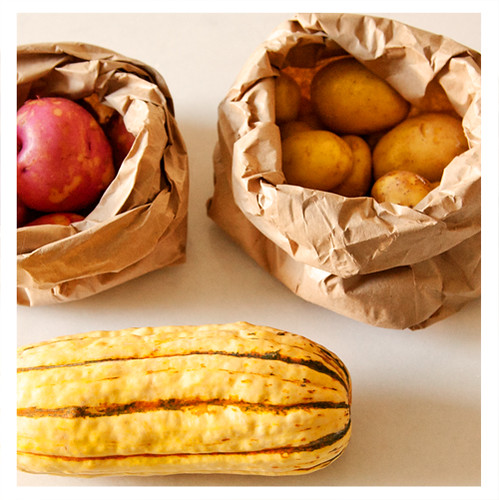I love a well organized kitchen and pantry. Sadly, since moving to San Francisco, all of the places I've lived have lacked a pantry. No pantry means one has to get creative with storage. Some solutions, while pretty, aren't always best at keeping food. I'm now on a mission to organize my kitchen with prevention of food spoilage in mind.
Right now winter vegetables are available from our CSA, some of which I'm not very familiar with -- hard or winter squash varieties for example. And, with cubes until recently on a soft foods diet we didn't go through what I was buying as quickly as before. So, I was seeing potatoes turn green or shrivel. Squash rot. Garlic turn to dust. Seeing this waste a light bulb went on: I must be storing the vegetables wrong. To my cookbooks and the Internet I went in search of the right way(s) to keep them. And I discovered, or rather confirmed, I was doing it wrong.
General Guidelines for Storing Vegetables
Most of us don't have walk-in pantries, so we can't always maintain an optimal temperature of 40 to 45 degrees Fahrenheit (4 to 7 degrees Celsius) with a relative humidity of 80 to 90 percent (1). We can do the following:
- Keep vegetables dry; excess moisture can promote spoilage.
- Do not wash, peel, or trim vegetables, other than to immediately remove leafy green tops on beets, turnips, carrots, and radishes, until just before use.
- Store separately, or wrap well, vegetables that give off odors, such as onions and garlic, and that can permeate other foods.
Storage guidelines specific to the type of vegetable follow.
Winter Squash
Depending on how quickly you plan on eating your squash determines where you'll want to keep it. If you're planning on using within the week, you can store it in your refrigerator in a paper bag; avoid storing squash in plastic bags as this traps moisture and may encourage rot (4). Humidity should be relatively low: 30 to 50 percent (2).
Hard squash keeps well if kept at cool room temperature; depending how they were stored prior to your purchase they can keep for at least a month (3). Squash hung in net bags or in wire baskets, which allow air to circulate, can keep for up to three months (4).
Potatoes
Potatoes are actually pretty delicate. Two things you should never do with most potatoes: refrigerate them which alters the starch or wash them before you plan to use them which causes them to dry out. (New potatoes, those harvested while the plant is still leafy green, should not be stored long term. Keep them in a plastic bag poked with holes (or reusable produce bag (*affiliate link)) for no more than three days in your refrigerator (3).)
You want to avoid bruising potatoes or exposing them to light (causes them to turn green). Potato varieties that store well are Katahdin, Kennebec, Yellow Finn, and Yukon Gold (2). First Light Farms of Petaluma, CA grows both dry-farmed, organic Yellow Finn and Yukon Gold varieties and more and are available through Good Eggs in the Bay Area.
Keep your potatoes in a cool, well-ventilated place. "[I]deal storage temperature for potatoes is 35 to 40 degrees, though they will usually keep for several months at 45 to 50 degrees (2)."
Sweet Potatoes
Sweet potatoes are even more delicate than potatoes and should be handled with care to avoid bruising. Like potatoes, sweet potatoes should also not be stored in the refrigerator. Store in a cool, well ventilated place and use within a couple of days (4).
Onions
Onions are another vegetable that shouldn't be refrigerated. Store them loose, in a cool, dark, dry, well ventilated place, for up to two weeks (4). When choosing which onions to store: eat those that are extra-large and mild in flavor as the same chemicals that make onions pungent make them good keepers (2). Storage onion varieties include: Yellow Globe, Downing Yellow Globe, Yellow Globe Danvers, and Ebenezer. Red storage varieties include Southport Red Globe and Wethersfield (5). Dirty Girl Produce the farm that currently supplies the onions available through Good Eggs in the Bay Area does not grow storage varieties; they harvest Gold Coin Cippollini and Gunnison.
Garlic
Garlic can be kept loose, unwrapped in the refrigerator, or in a cool dry place for several weeks (4). Dryness and complete darkness are essential to long-term storage of garlic (2).
P.S. Don't feel like commenting? Strike up a conversation with me elsewhere: Twitter, Instagram, Facebook, Google+, or Pinterest.
Credits: All layouts designed by Eden Hensley Silverstein for The Road to the Good Life. Product images taken by their respective sellers: Gardener's Supply Company and Amazon.
References: 1. Conway, Linda Glick. The Professional Chef (*affiliate link). 2. LaLiberte, Kathy. "Keeper Crops: How to Store the Summer Harvest for the Winter Kitchen." Gardener's Supply Company. 3. Mogannam, Sam and Dabney Gough. Bi-Rite Market's Eat Good Food: A Grocer's Guide to Shopping, Cooking & Creating Community Through Food (*affiliate link). 4. Peterson, James. Vegetables, Revised: The Most Authoritative Guide to Buying, Preparing, and Cooking, with More than 300 Recipes (*affiliate link). 5. "How to Store Onions." Vegetable Gardening Online.
This post contains affiliate links, identified with (*affiliate link) following the linked text. I feature products that I own or that I am considering purchasing regardless of referral fees. I own all of the books referenced in this post. All opinions presented are my own.

